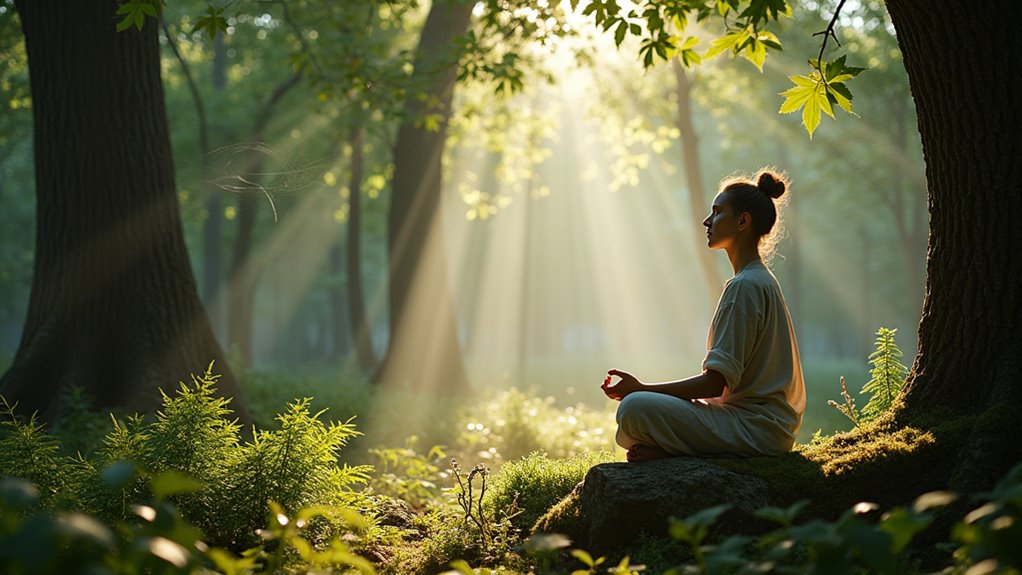Nature's healing powers can transform your mental well-being in as little as 15 minutes outdoors. When you spend time in natural settings, your brain produces more alpha waves linked to relaxation while reducing stress hormones like cortisol. You'll experience improved focus, sharper problem-solving abilities, and enhanced emotional regulation. Activities like forest bathing, gardening, or simply walking in a park boost your serotonin and dopamine levels, leading to reduced anxiety and depression symptoms. Whether you're in an urban garden or wilderness area, connecting with nature offers scientifically proven pathways to better mental health. The deeper you explore nature's therapeutic benefits, the more profound your healing journey becomes.
Key Takeaways
- Regular exposure to nature reduces stress hormones like cortisol while increasing mood-boosting chemicals like serotonin and dopamine.
- Just 15 minutes of forest exposure lowers blood pressure, heart rate, and anxiety while improving focus and memory.
- Nature-based activities like gardening and forest bathing promote mindfulness and provide therapeutic benefits for depression and anxiety.
- Green spaces in urban environments create opportunities for social connection, physical activity, and mental restoration.
- Spending time outdoors reduces prefrontal cortex activity, leading to fewer negative thoughts and better emotional regulation.
The Science Behind Nature's Effects

While researchers have long suspected nature's positive impact on mental health, recent neuroscience studies confirm that exposure to natural environments triggers measurable changes in brain activity.
When you spend time outdoors, your brain produces more alpha waves, which are linked to relaxation and reduced anxiety. Your prefrontal cortex, responsible for negative thoughts and rumination, becomes less active.
You'll find that nature experiences lower your cortisol levels and blood pressure while increasing the production of feel-good hormones like serotonin and dopamine.
Even brief encounters with natural settings can improve your attention span and working memory. The sounds, scents, and sights of nature activate your parasympathetic nervous system, promoting a state of rest and recovery that's essential for mental well-being.
Benefits for Mental Health
Because regular exposure to nature provides such powerful effects on the brain, it can significantly improve various aspects of mental health.
You'll find your anxiety and stress levels dropping after spending time outdoors, while your mood naturally elevates. Nature's calming influence helps reduce symptoms of depression and ADHD, allowing you to think more clearly and focus better.
When you make outdoor time a regular part of your routine, you'll notice improved sleep patterns and enhanced emotional regulation.
Your self-esteem will likely increase as you connect with the natural world, and you'll develop greater resilience to life's challenges.
Nature's therapeutic benefits extend to reducing rumination – those persistent negative thoughts that can plague your mind – while fostering a deeper sense of peace and emotional well-being.
Forest Bathing and Wellness

You'll discover that forest bathing's roots stretch back to ancient Japanese traditions where Shinrin-yoku was practiced for spiritual and physical wellness.
Modern research has confirmed what our ancestors knew intuitively, showing that spending time among trees reduces stress hormones, lowers blood pressure, and boosts immune function.
Today you can join guided forest therapy sessions or practice on your own, making this healing tradition part of your regular wellness routine.
Origins and Ancient Practices
Although modern science continues to validate nature's healing effects, the practice of seeking wellness through forest immersion dates back thousands of years.
You'll find evidence of nature-based healing in ancient Chinese Taoist teachings, Native American traditions, and Japanese Shinto practices. These cultures understood that connecting with forests could restore balance to both body and mind.
In ancient Greece, you'd discover healing temples built in forested areas, where patients would rest among trees and natural springs.
Traditional Celtic druids performed their ceremonies in sacred groves, believing trees held spiritual and healing properties.
Today's forest bathing practices draw from this rich historical tapestry, combining ancestral wisdom with contemporary understanding.
You're actually participating in a tradition that's been helping humans find peace and healing for generations.
Scientific Benefits Revealed
While forest bathing may seem like a simple walk in the woods, modern research has uncovered powerful scientific evidence supporting its health benefits.
Studies show that spending time among trees can lower your cortisol levels, reduce blood pressure, and boost your immune system's natural killer cells.
You'll find that phytoncides – aromatic compounds released by trees – play a crucial role in these health improvements.
When you breathe in these natural compounds, your body responds by decreasing stress hormones and increasing relaxation. Research also indicates that forest environments can enhance your cognitive function, improve attention span, and reduce symptoms of depression and anxiety.
The evidence is particularly strong regarding stress reduction, with measurements showing significant decreases in heart rate and blood pressure after just 15 minutes of forest exposure.
Modern Wellness Applications
With these proven health benefits, it's no surprise that forest bathing has found its way into modern wellness programs worldwide.
You'll find certified guides leading forest therapy walks at spas, retreat centers, and corporate wellness events. Many healthcare providers now prescribe nature experiences alongside traditional treatments for anxiety, depression, and stress-related conditions.
You can incorporate forest bathing into your wellness routine through guided sessions or self-practice. Start by finding a natural setting – it doesn't need to be a vast forest. Urban parks, botanical gardens, or even a tree-lined street will work.
Turn off your phone, move slowly, and engage your senses. Focus on the textures of bark, the rustling of leaves, and the scents of soil and vegetation. Regular practice can help you build a deeper connection with nature while improving your mental health.
Green Spaces in Urban Settings
You'll discover that urban green spaces follow essential design principles for creating peaceful sanctuaries within busy cities.
Your local community gardens offer a perfect example of how nature can transform concrete landscapes into vibrant, living spaces.
These natural havens provide both environmental benefits and social connections, turning previously unused areas into thriving neighborhood gathering spots.
Urban Oasis Design Principles
Although city planners once focused primarily on efficiency and infrastructure, modern urban design increasingly emphasizes the vital role of green spaces.
You'll find several key principles guiding today's urban oasis designs, including accessibility, diversity, and connectivity.
When designing these spaces, you'll want to incorporate native plants that support local biodiversity while requiring minimal maintenance.
It's essential to create multi-functional areas that serve various community needs – from quiet meditation spots to active recreation zones.
You should also consider strategic placement of water features, which provide both aesthetic value and natural cooling effects.
Smart lighting, comfortable seating, and clear sight lines ensure these spaces remain safe and welcoming throughout the day.
Remember to include weather protection elements like shade trees and covered areas to encourage year-round use.
Community Gardens Transform Cities
Community gardens have emerged as powerful catalysts for urban transformation, breathing new life into formerly vacant lots and neglected spaces.
You'll find these green sanctuaries fostering connections between neighbors while producing fresh, local food in the heart of concrete jungles.
When you participate in community gardening, you're not just growing vegetables – you're building social bonds, improving food security, and enhancing urban biodiversity.
These spaces serve as outdoor classrooms where you can learn sustainable practices and share gardening knowledge across generations.
You'll notice how these gardens cool urban heat islands, reduce stormwater runoff, and create habitat corridors for pollinators.
They're proving that cities don't have to choose between development and green space – they can harmoniously blend both to create healthier, more resilient communities.
Nature-Based Therapeutic Programs

How are mental health professionals incorporating the healing power of nature into their practices?
Through structured programs like wilderness therapy, horticultural therapy, and forest bathing, therapists are guiding clients to connect with natural environments as part of their treatment plans.
You'll find these programs tailored to various needs.
Wilderness therapy helps troubled teens build confidence through outdoor challenges.
Horticultural therapy uses gardening activities to improve motor skills and reduce anxiety.
Forest bathing sessions teach you mindfulness techniques while immersed in woodland settings.
These nature-based interventions aren't just trendy – they're backed by research showing reduced stress hormones, improved mood, and better cognitive function.
Your therapist might recommend spending time in nature alongside traditional treatments, creating a holistic approach to mental wellness.
Outdoor Exercise and Brain Function
When you take your workout into the great outdoors, you're doing more than just burning calories – you're supercharging your brain.
Research shows that exercising in natural settings enhances cognitive function more effectively than indoor workouts. Your brain releases higher levels of mood-boosting endorphins and serotonin when you're active in nature.
You'll notice improved memory, sharper focus, and better problem-solving abilities after spending time exercising outside. The combination of physical activity and natural surroundings reduces cortisol levels while increasing blood flow to your brain.
Whether you're jogging through a park, cycling on a mountain trail, or practicing yoga in your backyard, you're giving your brain a double dose of benefits – from both the exercise and the exposure to nature.
Gardening as Mental Medicine

If outdoor exercise energizes your brain, putting your hands in the soil takes mental healing to an even deeper level. When you garden, you're engaging in a mindful activity that reduces cortisol levels and increases serotonin production.
You'll notice your anxiety melting away as you focus on nurturing living things.
Studies show that gardening can help combat depression, improve attention span, and boost self-esteem. You're not just growing plants – you're cultivating peace of mind.
The repetitive nature of watering, weeding, and pruning creates a meditative state that calms racing thoughts. Plus, you'll gain a sense of accomplishment as you watch your garden flourish.
Whether you're tending to a vast backyard or a few potted herbs, you're participating in an ancient practice that connects you to the earth's healing power.
Digital Detox Through Nature
By stepping away from screens and immersing yourself in nature, you'll reset your overstimulated nervous system. The constant notifications, blue light exposure, and digital demands drain your mental energy and increase stress hormones.
Nature offers a perfect antidote to tech overload. You can start small – leave your phone behind during a 15-minute walk in your local park. Notice the rustling leaves, chirping birds, and changing sky.
As you build this habit, extend your nature time to longer periods. Try forest bathing, beach walks, or hiking trails without digital interruptions.
Your brain will thank you as natural settings lower cortisol levels and improve focus. You'll find yourself sleeping better, thinking clearer, and feeling more grounded when you regularly unplug in nature's presence.
Building a Nature-Connected Lifestyle

Though a complete nature connection may seem daunting at first, you can weave outdoor experiences into your daily routine through simple, intentional choices.
Start by taking your morning coffee outside, walking during lunch breaks, or doing light stretches in your backyard. Create a garden, no matter how small, or nurture indoor plants to bring nature closer.
Transform your weekends by planning micro-adventures: explore local trails, visit nearby parks, or join community nature groups.
You'll find that these small shifts gradually reshape your lifestyle. Set up an outdoor workspace when weather permits, and replace some indoor exercises with outdoor alternatives.
Remember to engage all your senses – feel the breeze, listen to birds, and notice seasonal changes. Soon, you'll discover that nature isn't just an escape but an essential part of your daily life.
Frequently Asked Questions
Can Children With ADHD Benefit From Nature Therapy More Than Adults?
While both children and adults with ADHD can benefit from nature therapy, you'll find that children often show more significant improvements.
Their developing brains are more adaptable, and they naturally respond better to sensory experiences in nature.
You'll notice that outdoor activities help reduce their hyperactivity, improve focus, and boost their self-regulation skills more effectively than in adults with ADHD.
How Long Should I Spend in Nature Daily to See Improvements?
While you're rushing through life indoors, nature patiently waits to restore your balance.
You'll start seeing benefits with just 20-30 minutes of daily outdoor time, but spending 2-3 hours in nature weekly offers optimal results.
You don't need to do it all at once – break it into smaller chunks that fit your schedule.
Walking in parks, sitting in gardens, or simply working outdoors can all contribute to your nature therapy time.
Are Indoor Plants as Effective as Outdoor Nature Experiences?
While indoor plants offer some benefits, they can't fully replicate the complete sensory experience you get outdoors.
You'll gain some advantages from houseplants, like improved air quality and mood-boosting visual elements, but you'll miss out on crucial elements like natural sunlight, fresh air, and the full spectrum of nature sounds.
For maximum mental health benefits, you should combine indoor plants with regular outdoor nature experiences.
What's the Best Time of Day for Nature Therapy Sessions?
Like a sunflower following the sun's arc across the sky, you'll find your optimal nature therapy time between early morning and mid-morning.
You'll benefit most from sessions between 6-10 AM when your cortisol levels naturally peak and your mind is most receptive.
If morning doesn't work, try sunset hours when the day's heat subsides and nature's transition creates a calming atmosphere.
Does Nature Therapy Work in Extreme Weather Conditions Like Rain or Snow?
You can practice nature therapy in any weather, but you'll need proper preparation and safety precautions.
Rain and snow can offer unique therapeutic experiences, as they engage different senses and create distinct atmospheres. However, you shouldn't attempt nature therapy in severe conditions like thunderstorms, blizzards, or extreme temperatures.
Instead, choose moderate rain or gentle snowfall when you're properly equipped with weather-appropriate gear.
Conclusion
While you're scrolling through screens indoors, nature's medicine cabinet stands ready outside your window. You don't need to choose between modern life and natural healing – they can work together. By weaving green moments into your daily routine, you'll transform ordinary days into opportunities for renewal. Whether it's a morning walk or weekend wilderness trek, nature's therapy is always open, always free, and always healing.

Leave a Reply